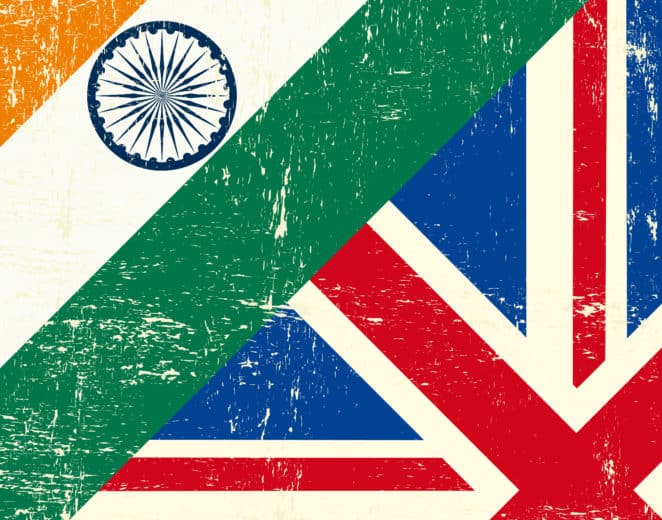UK-India economic relations: the current landscape
We examine the current state of UK-India economic relations in the run-up to Theresa May's first non-EU bilateral trip to India next week

The current landscape
The UK-India economic relationship is good, but improvement could be made in a number of areas. In absolute terms, UK-India bilateral trade grew by 170% between 2004 and 2014. Yet, India’s overall trade grew by 800% in the same period. In relative terms, UK-India trade fell by around 8% in 2014-15. Additionally, India’s goods exports to the UK grew by 226% between 2004 and 2014. The UK’s goods exports to India grew by 153% in the same period.
In 2015-16, the UK was just India’s 12th largest trading partner. India trades more with Indonesia, Germany and Japan, than with the UK. Plus, despite the UK being the second largest exporter of services in the world and India having the second fastest growing services sector with a CAGR of 9%, UK-India services trade is disappointingly low. In 2014, the UK imported over 10 times more services from the US than it did from India, and the UK’s service exports to India makes up just 7% of its total service exports to Asia.
At present, Indian companies can buy from and invest in the UK 10% more cheaply than in June, due to the depreciation in Sterling. Indian businesses will find UK companies are increasingly looking to India for partnerships. And, of course, the UK economy remains fundamentally strong – it is the fifth largest economy in the world, the second fastest market in the G7, and one that, in the words of PM Theresa May, is “bold and outward looking.” Just like India.
For UK companies, India is increasingly open to FDI and it is moving up the ease of doing business rankings. Just as importantly, there is a rising interest demand for UK goods, services, technology, and know-how to help achieve the goals set out in programmes such as Make in India, Digital India, Skill India and Swachh Bharat. And there are several areas where more bilateral trade and investment can bring near term benefits to both countries.
In terms of the investment relationship between the two countries – it has remained strong, both in the run up to, and follow-on from the EU referendum. The UK has been the largest G20 investor in India since 2000 and India has been the third largest source of FDI into the UK in terms of number of projects, both in 2014-15 and 2015-16. Figures released in August 2016 by the Department of International Trade, show India invested in 140 projects in the UK in the last FY. This is just behind China (156 projects), but some way behind the 570 US projects.
UK-India trade & investment
Unfortunately, the same is not true for bilateral trade between the UK and India. In the financial year 2015-16, the UK did not feature in India’s top 10 trading partners, ranking at 12th. India trades more with Indonesia, Germany and Japan, than with the UK.
Plus, despite the UK being the second largest exporter of services in the world and India having the second fastest growing services sector with a compound annual growth rate of 9%, the services trade between the two countries is disappointingly low. In 2014, the UK imported over 10 times more services from the US than it did from India, and the UK’s service exports to India makes up just 7% of its total service exports to Asia.
It is encouraging that there has been a consistent growth in the number of projects the UK receives from India. With a growth of 58%, the UK received its highest number of projects from India in 2015. Indian companies employ nearly 110,000 people in the UK and in 2016 the number of Indian companies growing at more than 10% has nearly doubled, according to the CII Grant Thornton ‘India meets Britain’ report in 2016
Future prospects
At the UK India Business Council, we seek to advocate a holistic approach to trade and investment encouraging both Indian companies to sell to the UK and vice-versa. This enables a relationship to develop which is mutually beneficial to both countries.
The proposed change to the model Bilateral Investment Treaty is undesirable at the moment since it is widely being considered to be less investor friendly than the previous model.
There is also an opportunity with JETCO, which should also be used as a mechanism to encourage trade and investment between India and the UK, alongside the CEO Forum – which can provide further opportunities for collaboration.
India’s ‘Ease of Doing Business’ rankings have risen under Modi as a result of his government’s reforms, but there is much more work to be done – the Goods and Services Tax (GST) being the starting point of such work.
It is clear that Modi is moving the domestic economy in the right direction, and in the UK India Business Council’s ‘Modi Government Progress Report,’ published this year, these reforms and the positive impact they are having is evident.
But there are significant areas for improvement. UK-India bilateral trade is waning and we need to look at ways of rectifying this – starting with encouraging more UK exports to India in the light of the UK’s decision to exit the EU.
UK-India trade has the potential in the coming years to become grow exponentially, and with UK Prime Minister Theresa May choosing India as her first non-EU bilateral visit, it is clear that India remains the UK’s key post-Brexit opportunity.
To read our full analysis of the UK-India relationship please follow this link







